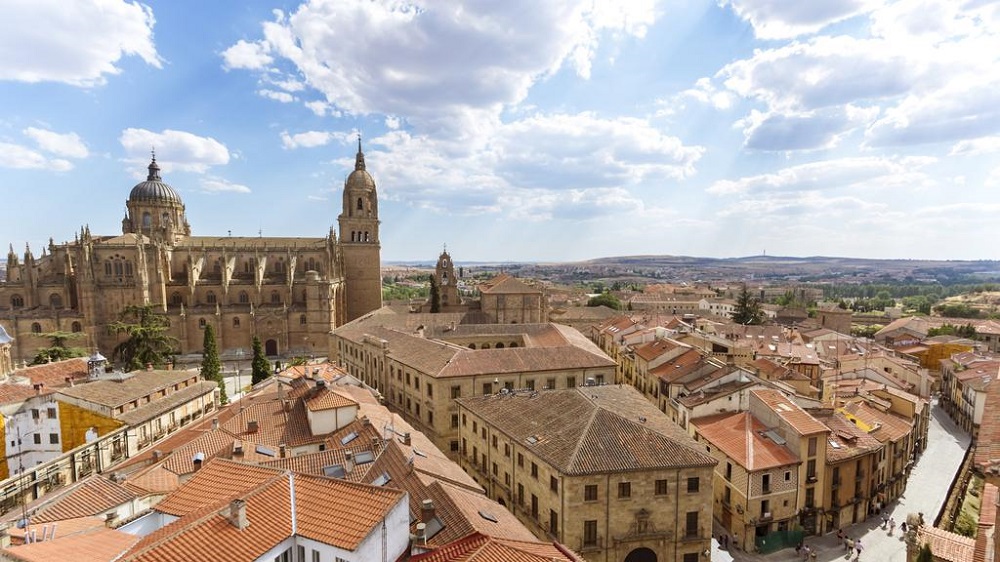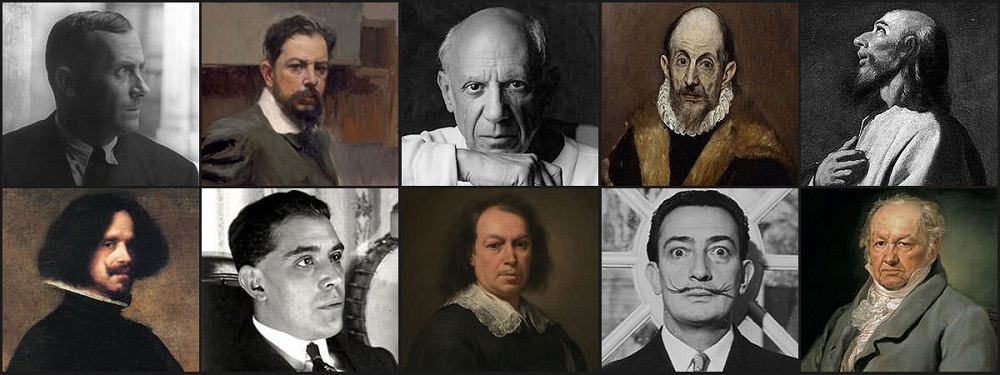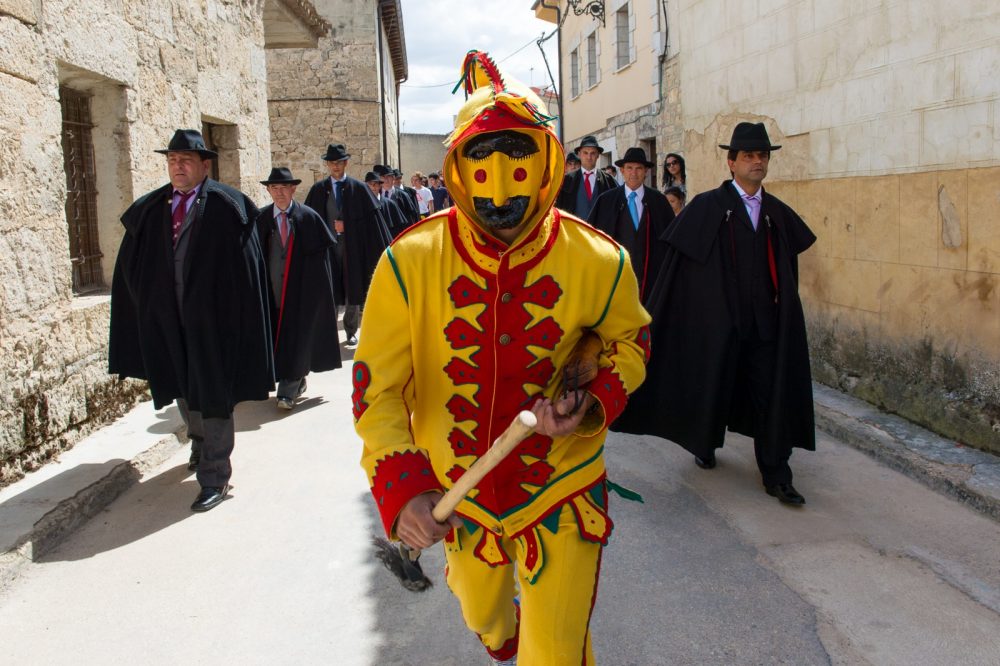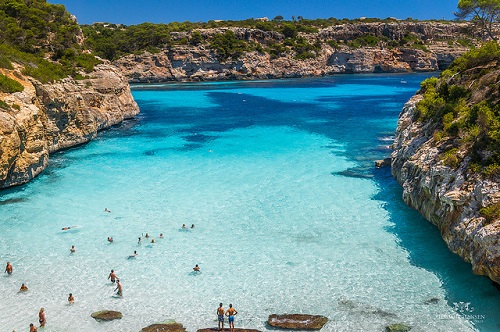Salamanca located in the north-western part of Spain, it is a city where you will find art and beauty. It was declared a UNESCO World Heritage Site in 1988 and was home to the impressive historic landmarks, with extraordinary examples of different architectural styles: Romanesque, Gothic, Baroque and Plateresque. The sights of Salamanca attract tourists from all over the world because it continues to be an important center for cultural experiences and exchange in the present day.
Discover this charming city with our list of the reasons why you should visit Salamanca at least once in your life.
1- Plaza Mayor:
 via – planetware
via – planetware
The plaza mayor is considered one of the largest squares in Spain. Besides, the most magnificent in the country and its Baroque architecture and intricate decorations are a sight to behold. It was built in two phases and finally completed in 1755.
This beautiful public square at the center of Salamanca is considered one of the emblems of the plazas in Spain. Firstly, The Square contains small shops, restaurants, and musical groups are layout around the bustling square giving some entertainment. Secondly, the plaza ruled with three buildings in a uniform architectural style which are the Churriguera-style Ayuntamiento (Town Hall) by Andrés García de Quiñones and the Pabellón Real (Royal Pavilion) by Alberto de Churriguera. At the southwest corner of the Plaza Mayor, there is a magnificent renaissance palace; which is the majestic main attraction of Salamanca city center it is called the Palacio de Monterrey, with the square surrounded by a quintessentially Spanish box of arcades.
Historically, this broad square of Plaza Mayor has witnessed as a setting for ceremonial occasions as well as bullfights until the 19th century. Besides, The Baroque architecture of the encompassing buildings is a lot to take in, from the detailed antique shutters and stonework to the plaques, statues, and medallions bearing faces. Plaza Mayor is also where the visitors can find their pleasure.
2- Salamanca’s Art Nouveau and Art Deco Museum:
 via – museocasalis
via – museocasalis
Art Deco and Art nouveau museum is one of the most celebrated in the region and exhibits artistic masterpieces from the 19th and the 20th centuries. Besides, the impressive building was originally a private palace and was eventually opened as a museum in 1995.
Moreover, the artifacts range from inspiring collections of paintings, sculptures to ceramics and art deco pieces. The objects displayed contain the intricate glass plays of light make it one of the most attractive architectural constructions in the country; and the largest collection of porcelain dolls in the world and its chryselephantine statuettes and ivory pieces, furniture, jewelry, antique toys, and even a Fabergé egg.
3- Food tour:
 via – worldfood
via – worldfood
Due to Salamanca’s location in the center of Spain, the cuisine demonstrates rural impacts and features a sort of tasty specialties. Also, you will find top-quality produce in Salamanca.
The province has a large number of restaurants, meaning you can taste all types of food: from home-style dishes, traditional, to creative and international cuisine, as well as restaurants specializing in meat, seafood and fish.
While in Salamanca you should try typical foods such as Hornazo is a pie filled with egg and other delicious ingredients as pork loin, chorizo sausage, ham. It was traditionally served throughout Easter week, although it can now be found all year round. Also, you can savor Guijuelo ham and cured meats, morucha beef, Armuña lentils and sweets such as perrunillas (pastries) and bollo maimón.
4- The Roman Bridge:
 via – spainisculture
via – spainisculture
The roman bridge has prime historical importance. Besides, it is one of Salamanca’s most striking constructions and living proof of the city’s antique origins and cultural significance. The Bridge represents the Salmantine Art, impacted by Celtic elements and provides magnificent views over the Old and the New Cathedral. As well it was declared a National Monument and is especially majestic by night when it is lit up.
Historically, The Roman Bridge dates back to the first century CE and has been a part of Salamanca’s coat of arms since the 13th century. It was founded by a Celtic Tribe, defeated by Hannibal and later controlled by the Romans. The bridge represents the city’s identity with more than half of its original stone arches, Roman walls and defensive turrets still stands today, which gives a chance to adore more of Salamanca.
5- Casa de las Conchas (House of Shells):
 via – saposyprincesas
via – saposyprincesas
This Renaissance palace built in the 15th century, it was the townhouse of Talavera Maldonado who was a Knight of the Order of Santiago. The most remarkable feature of the palace is the facade designed with carvings of scallop shells, the symbol of medieval pilgrims traveling the Way of Saint James to Santiago de Compostela. Over three hundred shells sculpted from sandstone decorated the outer walls of the building.
During the day, the sunlight produces a magnificent effect on the pattern of the facade. The building also has Mudejar figures elements, typical of Isabelline Art. Its entrance door with a Gothic coat of arms and the intricate wrought-iron grilles on the windows.
Today, it accommodates the Salamanca Public Library and an information office. Visitors may visit the inside courtyard of the building, which is a lovely two-story space.
6- Salamanca University Historic Buildings:
 via – awayandfar
via – awayandfar
Salamanca University is the most astonishing university of learning in Europe during the middle ages. Founded in 1218, as the first university in Spain and modeled after the University of Bologna in Italy. Additionally, it recognized the Copernican system which is the concept that the sun is the centre of the universe at a time when the church still acclaimed this idea as heresy.
Furthermore, the university is decorated with elegant Renaissance and Baroque buildings, the impressive Patio de Escuelas courtyard is a monument within Salamanca University. Several important landmarks are found here, firstly, the University’s Escuelas Mayores was established in 1428, is the university preparatory schools, which were known as an unmatched masterpiece of Plateresque ornamentation. Secondly, the Hospital del Estudio was built in 1533 as a hostel for poor students.
Statues on the front of the buildings contain Hercules, medallions of Christ, and Theseus, and busts of Saint Peter, the coat of arms of the Empire of Charles V and Saint Paul. Thirdly, on the south side of the square is the Sala Calderón de la Barca is the old University Library designed with a popular ceiling painting, Cielo de Salamanca was Sky of Salamanca by Fernando Gallego in 1480. The painting exhibits the knowledge of astronomy in the late 15th century, with signs of the Zodiac, various constellations, and the four winds.
7- Museum of Automotive History:
 via – worldtourisminfo
via – worldtourisminfo
The Museum of Automotive History has different exhibitions as the history of early attempts at motorized vehicles, the evolution of self-powered vehicles and different auto manufacturing, design, and technological advances in the industry.
The museum also provides rotating displays that concentrate on general topics, from road safety to cultural niches like the motorcycles of Salamanca. Among the 140-plus vehicles on exposition are American, European, and Asian models, from the earliest examples to the cutting edge, including Formula 1 cars that have been featured in world-class competitions.
8- Old and New Cathedrals:
 via – travelguide
via – travelguide
Salamanca possesses two impressive cathedrals that stand side by side. Each has been designed in a different style; the New Cathedral built in the Gothic style and completed in 1733, while the Older Cathedral finished in the 14th century also offers visitors the chance to discover a truly impressive Romanesque monument.
The Cathedral Nueva of Salamanca is one of the artistic monuments of this city by the river Tormes, and it demonstrates a rich monumentality that clashed with the sober simplicity of the close Romanesque cathedral. As well, it includes a large range of artistic styles as Gothic blends with Baroque, which in turn feeds on Renaissance to become stone, figures, and glass.
It is a splendid cathedral especially; the choir is one of the main Spanish Baroque, was built by Alberto Churriguera. Besides, there are magnificent pillars and a majestic Baroque dome rising above the transept to reach a height of 80 meters. The best thing for visitors to do is get lost in it and forget about time.
The second, Cathedral called Vieja of Salamanca known as the Torre del Gallo and considered as one of the most spectacular Romanesque monuments in Europe generally and the perfect Romanesque cathedral particularly in Salamanca. Each corner of both cathedrals surprises visitors with impressive detail that can be unlimitedly observed from multiple angles.
9- Convento de San Esteban:
 via – pixabay
via – pixabay
At this point, it should become clear that among the university and palaces buildings of Salamanca, there are plenty of religious sites too. One of them is the Convento de San Esteban was finished in the early 17th century and is known as a Dominican monastery replacing an earlier cloister. Besides, the building is located in the Plaza del Concilio de Trento (council of Trent) in the city of Salamanca.
Furthermore, the facade encompasses the front of the church and the adjacent monastery portico. The front of the church is one of the impressive examples of the Plateresque design. The portico, contained arches, is gifted by Italian renaissance, its plain decoration contrasting with the ornamental exuberance of the church facade.
Salamanca looked fabulous by day, wait until you get a load of the city by night! Like any good Spanish city. Besides, it comes truly alive at night and particularly in Plaza Mayor is unique when illuminated.


 Top 10 Most Famous Spanish Artists and their Arts
Top 10 Most Famous Spanish Artists and their Arts
 El Colacho, the Baby Jumping Festival in Murcia Spain
El Colacho, the Baby Jumping Festival in Murcia Spain
 Discover The Most Beautiful Places In Mallorca, Spain
Discover The Most Beautiful Places In Mallorca, Spain